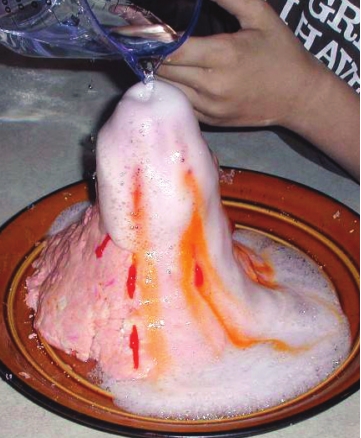Science in the home
With the holidays around the corner, some parents might be wondering what types of activities there are to do while the children are out of school. Sure, you could all hop into the family car and experience the animals at Gators and Friends, an exhibit at the Bossier Arts Council or even travel to Natchitoches for the Festival of Lights. But, in lieu of spending money on gas, there are several projects you can do as a family at home this holiday season, including making homemade volcanoes.
This project uses baking soda and vinegar.
Besides the fact that it gives a “wow” effect, constructing it will be an opportunity to teach your young ones about basic chemistry.
To get started, you’ll need six cups of flour, two cups of salt, four tablespoons of cooking oil, warm water, a plastic soda bottle, half a teaspoon of dishwashing detergent, food coloring, vinegar, baking dish or other pan and two tablespoons of baking soda. Although the ingredients for this project are non-toxic, they are not tasty.
First, you’ll want to start with constructing the cone of your baking soda volcano. Do this by mixing your flour, salt, cooking oil and two cups of warm water. The resulting concoction should come out smooth and firm. (Feel free to add more water if needed.)
Stand the plastic soda bottle in your baking pan and mold a volcano shape using the mixture. It’s important not to cover the hole at the top of the bottle or to drop any of the dough into the bottle.
Fill the majority of the bottle with warm water; a funnel might come in handy for this. Add some red food color to the water. You can play around with orange, yellow or any other color for a brighter display.
Next you’ll want to the detergent into the bottle. By helping to trap the bubbles produced by the reaction, the detergent aids in creating a more visual lava.
Now it’s time to add the baking soda. Finally, show time! Begin pouring vinegar into the bottle and voilà – eruption time! Feel free to “ooh” and “ahh.” All in all, this project takes about half an hour.
So, how does this happen? Simply put, this experiment is a perfect example of an acid-base reaction.
For starters, the lava is the result of a chemical reaction taking place between the baking soda (sodium bicarbonate) and vinegar (acetic acid). This reaction creates carbon dioxide gas, which also happens when a real volcano erupts.
As this reaction occurs, pressure builds inside the bottle until the gas bubbles out of the volcano. Remember, the detergent helped trap these bubbles initially.
Visit Planetary.org for more intricate homemade volcano projects, which use cardboard and modeling clay. You can also learn more about acids and bases at sciencebuddies.org.
In addition to constructing and erupting a homemade, non-edible volcano, there’s also the option of baking a volcano cake, complete with colorful decorating icing to denote lava. The Food Network’s website provides a recipe for a red velvet-based volcano cake, which includes incorporating dry ice for a cool, smoky effect.
Whether your volcano is
edible or not, I hope you enjoy sharing a simple – and possibly sweet –
science experiment with your family.
Try it out: Learn how to do this project at video.about.com/chemistry/Erupting- Volcano.htm.
Karen
E. Wissing is the public relations and marketing manager for Sci-Port:
Louisiana’s Science Center. Part of Sci-Port’s mission is to spark
curiosity about the world around us, including within informal settings.
Email your questions, comments or suggestions to kwissing@ sciport.org. Follow us on Facebook at facebook. com/sciport.
Search: The Forum and City Life